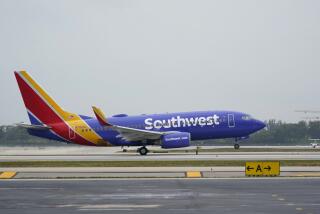Plane in Fatal Crash Took Off Despite Flaw
- Share via
WASHINGTON — The fault-detection system of a Saudi-bound U.S. military transport plane was out of order when the plane crashed Aug. 29, killing 13 people. But the aircraft was permitted to take off anyway, the Air Force said Thursday.
The crash apparently was caused by a faulty thrust-reverser that kicked in during takeoff, stalling the plane’s climb and hampering the pilots’ ability to control it, according to a report on the accident.
But the plane’s flight crew probably was not warned of the malfunction because one of the craft’s safety systems was not working.
Accident investigators said the C-5A Galaxy was operating under a waiver from the Air Force when it took off during the fourth week of deployments to Operation Desert Shield.
A thrust-reverser stuck in the “on” position would produce drag capable of slowing an aircraft’s acceleration and hindering its efforts to climb on takeoff.
Had the plane’s fault-detector system been working, a light would have alerted pilots to the thrust-reverser’s malfunction and the plane’s hydraulic system would have reacted to correct the problem.
The crash occurred 2,765 feet from the end of the runway at Ramstein Air Base in Germany. The flight was bound for Dhahran, Saudi Arabia, carrying a crew of nine and eight military passengers, as well as food and medical supplies.
It was the worst accident since the deployment of U.S. troops to the Middle East began. With the deaths of two Marines in unrelated incidents last Wednesday, the toll of Operation Desert Shield climbed to 56.
Capt. George Sillia, an Air Force spokesman, said the waiver permitting the C-5A to take off was a “standing regulation” for “everyday use” and not an emergency exception issued for the crisis deployment. The waiver was intended to permit the crew to fly from Ramstein to nearby Rhein Mein Air Base to get the problem fixed.
More to Read
Sign up for Essential California
The most important California stories and recommendations in your inbox every morning.
You may occasionally receive promotional content from the Los Angeles Times.










